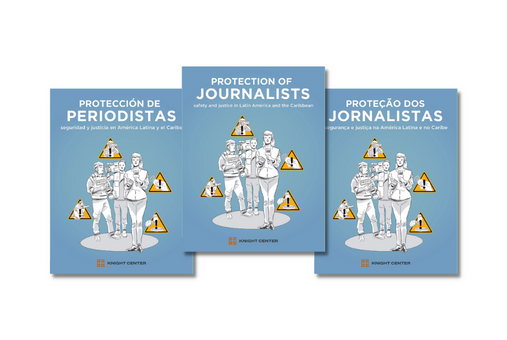
The Knight Center for Journalism in the Americas has published a new e-book on the safety and protection of journalists in Latin America and the Caribbean.
“Protection of Journalists: Safety and Justice in Latin America and the Caribbean” is the product of eight months of articles originally published in the Knight Center for Journalism in the Americas’ digital magazine, LatAm Journalism Review. The e-book, which was funded by UNESCO’s Global Media Defense Fund, can be downloaded for free in English, Spanish or Portuguese from the JournalismCourses.org digital library.
The e-book is a compilation of 14 stories that were published from December 2021 to July 2022, and focused on four major topics:
The e-book presents country case studies and never-before reported details of violence targeting press professionals. It also includes guides on how to stay safe while reporting on protest and violent conflict. And, it looks at delays in setting up systems to protect journalists, as well as flaws in the offices meant to prevent impunity.
The authors take deep dives into countries such as Bolivia, Guatemala, El Salvador, Honduras and Mexico, but also include examples of journalists affected in Chile, Brazil, Colombia, Ecuador, Nicaragua, Peru and Venezuela. The lessons and case studies, however, can be applied to countries throughout the region.
“Throughout the 21st century, the situation of the press in Latin America has deteriorated,” Javier Garza, Mexican journalist and editor of the project, said in the e-book’s introduction. “If in the last years of the last century it was thought that democratic opening and technological innovation would bring a new climate of freedom of expression, in recent years the rise of organized crime and authoritarian regimes has created new risks.”
“To deal with them, journalists and authorities have tried to create different tools to improve security for those reporting,” Garza continued. “In this e-book, we set out to take a tour of these attempts, undertaken from different fronts: newsrooms, collectives of journalists, media associations, governments or prosecutors. And it is the journalists themselves who tell us about their experiences.”
The e-book was edited by Garza, an expert in safety issues affecting media, and coordinated by Teresa Mioli, Knight Center program coordinator. The stories were written by members of the LatAm Journalism Review team, as well as journalists from media outlets and journalist organizations in Latin America.
Special illustrations that accompanied the project were done by Pablo Pérez of Altais Comics, based in Medellín, Colombia.
“It’s our hope that our work helps reporters and editors with useful information about the safety of journalists in the Americas and the issue of impunity,” Professor Rosental C. Alves, Knight Center founder and director, said in the e-book’s prologue. “We also hope this e-book becomes a reference for organizations and people who are concerned about the safety of journalists in the Americas and beyond, at a time when the free press has been under an unprecedented wave of attacks.”